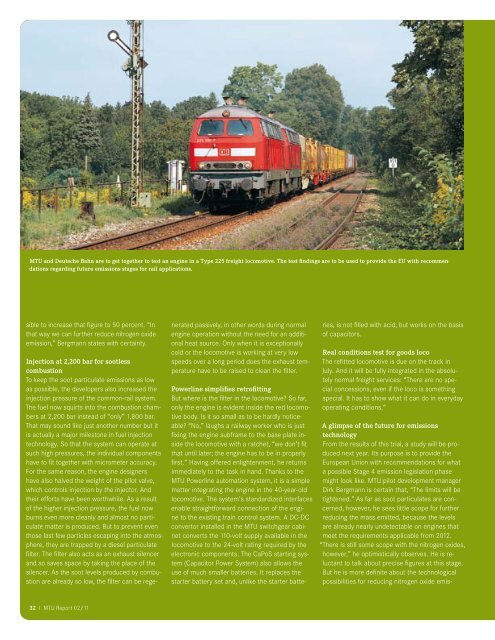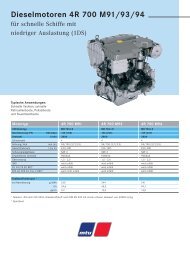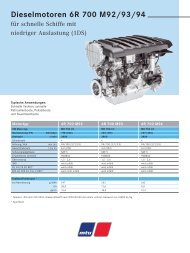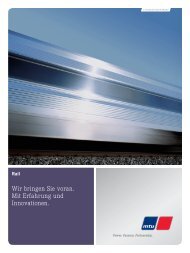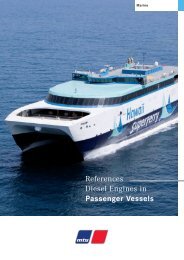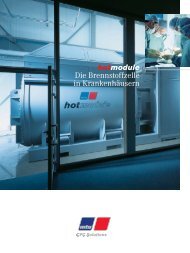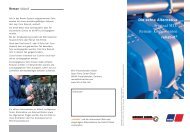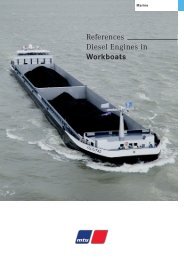You also want an ePaper? Increase the reach of your titles
YUMPU automatically turns print PDFs into web optimized ePapers that Google loves.
<strong>MTU</strong> and Deutsche Bahn are to get together to test an engine in a Type 225 freight locomotive. The test findings are to be used to provide the EU with recommen-<br />
dations regarding future emissions stages for rail applications.<br />
sible to increase that figure to 50 percent. “In<br />
that way we can further reduce nitrogen oxide<br />
emission,” Bergmann states with certainty.<br />
Injection at 2,200 bar for sootless<br />
combustion<br />
To keep the soot particulate emissions as low<br />
as possible, the developers also increased the<br />
injection pressure <strong>of</strong> the common-rail system.<br />
The fuel now squirts into the combustion chambers<br />
at 2,200 bar instead <strong>of</strong> “only” 1,800 bar.<br />
That may sound like just another number but it<br />
is actually a major milestone in fuel injection<br />
technology. So that the system can operate at<br />
such high pressures, the individual components<br />
have to fit together with micrometer accuracy.<br />
For the same reason, the engine designers<br />
have also halved the weight <strong>of</strong> the pilot valve,<br />
which controls injection by the injector. And<br />
their efforts have been worthwhile. As a result<br />
<strong>of</strong> the higher injection pressure, the fuel now<br />
burns even more cleanly and almost no particulate<br />
matter is produced. But to prevent even<br />
those last few particles escaping into the atmos-<br />
phere, they are trapped by a diesel particulate<br />
filter. The filter also acts as an exhaust silencer<br />
and so saves space by taking the place <strong>of</strong> the<br />
silencer. As the soot levels produced by combustion<br />
are already so low, the filter can be rege-<br />
32 I <strong>MTU</strong> Report 02/11<br />
nerated passively, in other words during normal<br />
engine operation without the need for an additional<br />
heat source. Only when it is exceptionally<br />
cold or the locomotive is working at very low<br />
speeds over a long period does the exhaust temperature<br />
have to be raised to clean the filter.<br />
Powerline simplifies retr<strong>of</strong>itting<br />
But where is the filter in the locomotive? So far,<br />
only the engine is evident inside the red locomotive<br />
body. Is it so small as to be hardly noticeable?<br />
“No,” laughs a railway worker who is just<br />
fixing the engine subframe to the base plate inside<br />
the locomotive with a ratchet, “we don’t fit<br />
that until later; the engine has to be in properly<br />
first.” Having <strong>of</strong>fered enlightenment, he returns<br />
immediately to the task in hand. Thanks to the<br />
<strong>MTU</strong> Powerline automation system, it is a simple<br />
matter integrating the engine in the 40-year-old<br />
locomotive. The system’s standardized interfaces<br />
enable straightforward connection <strong>of</strong> the engine<br />
to the existing train control system. A DC-DC<br />
convertor installed in the <strong>MTU</strong> switchgear cabinet<br />
converts the 110-volt supply available in the<br />
locomotive to the 24-volt rating required by the<br />
electronic components. The CaPoS starting system<br />
(Capacitor Power System) also allows the<br />
use <strong>of</strong> much smaller batteries. It replaces the<br />
starter battery set and, unlike the starter batte-<br />
ries, is not filled with acid, but works on the basis<br />
<strong>of</strong> capacitors.<br />
Real conditions test for goods loco<br />
The refitted locomotive is due on the track in<br />
July. And it will be fully integrated in the absolutely<br />
normal freight services: “There are no special<br />
concessions, even if the loco is something<br />
special. It has to show what it can do in everyday<br />
operating conditions.“<br />
A glimpse <strong>of</strong> the future for emissions<br />
technology<br />
From the results <strong>of</strong> this trial, a study will be produced<br />
next year. Its purpose is to provide the<br />
European Union with recommendations for what<br />
a possible Stage 4 emission legislation phase<br />
might look like. <strong>MTU</strong> pilot development manager<br />
Dirk Bergmann is certain that, “The limits will be<br />
tightened.” As far as soot particulates are concerned,<br />
however, he sees little scope for further<br />
reducing the mass emitted, because the levels<br />
are already nearly undetectable on engines that<br />
meet the requirements applicable from 2012.<br />
“There is still some scope with the nitrogen oxides,<br />
however,” he optimistically observes. He is reluctant<br />
to talk about precise figures at this stage.<br />
But he is more definite about the technological<br />
possibilities for reducing nitrogen oxide emis-


